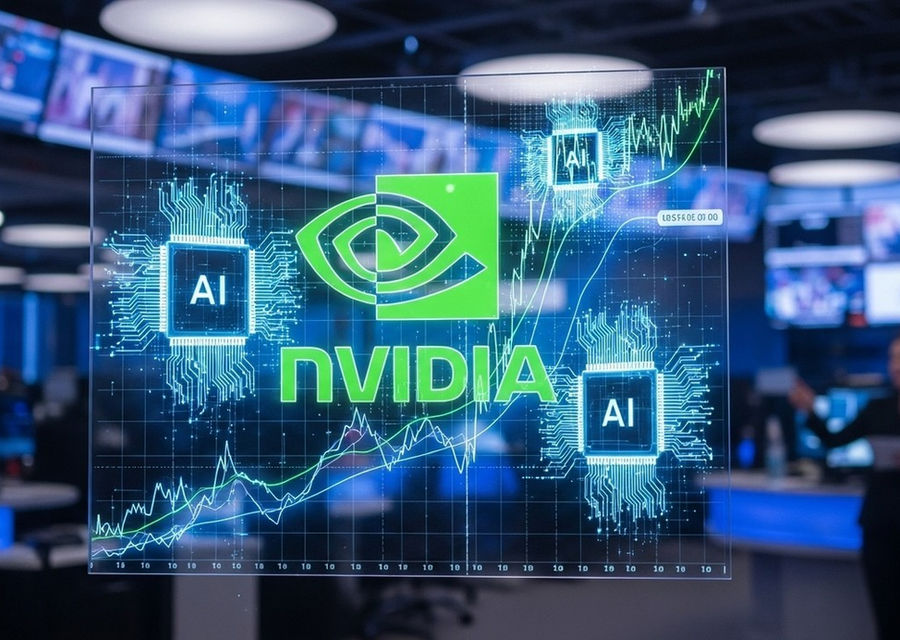Nvidia AI chip market: Stock Moves, Dell Guidance, and Alibaba's China Play
- THE MAG POST

- Sep 6
- 6 min read

Nvidia AI chip market realities are reshaping how investors gauge the AI hardware cycle, layering optimism about data-center demand with caution over government policy and competitive threats. Recent moves in Nvidia shares, Dell's softer earnings outlook, and Alibaba's China chip ambitions crystallize a broader truth: profits in AI hardware hinge as much on policy as on processor performance. Across this landscape, buyers and sellers weigh capacity expansions, supply chain resilience, and the pace of AI adoption, a dynamic that will shape portfolios for quarters to come. This article expands on those signals and their practical implications. In the Nvidia AI chip market, policy risks and competitive dynamics sit at the core of the current price action, demanding a nuanced read that goes beyond quarterly headlines.
Nvidia AI chip market dynamics: Dell’s drift and Alibaba’s China play
Nvidia AI chip market dynamics are reshaping how investors gauge the AI hardware cycle, where a handful of players set the tempo for momentum across data centers, accelerators, and the broader AI supply chain. Dell’s latest guidance and Alibaba’s foray into domestic AI chip development illuminate a landscape where demand, policy, and competitive substitutes interact in real time, often more decisively than quarterly revenue beats alone. The result is a sector that moves on policy headlines as rapidly as it does on processor specifications, demanding a holistic view of risk and opportunity for readers, traders, and technology strategists alike.
Dell's quarterly guidance and its ripple effects
Dell’s third-quarter outlook, framed around earnings per share near the mid-$2.5 range, underscored the sensitivity of AI infrastructure demand to business cycles and corporate budgets. The update carried implications beyond Dell’s own top line, signaling how downstream buyers influence server demand, compute refresh cycles, and supplier concentration in the AI stack. Investors responded not just to the headline numbers but to the cadence of conservatism versus optimism, a dynamic that can nudge the perceptions of Nvidia’s broader data-center opportunity and its pricing power in a competitive market.
Moreover, Dell’s exposure highlights how a relatively small segment of Nvidia’s revenue can still move sentiment given the sector’s correlation with enterprise IT spending. As a customer, Dell’s commentary feeds into a narrative about the health of enterprise AI deployments, the pace of hyperscale capex, and the resilience of the ecosystem that Nvidia purveys through software, platforms, and partnerships. In this environment, even modest guidance shifts can reverberate through valuations and risk models for technology equities tied to the AI hardware cycle.
Alibaba's AI chip ambitions and domestic competition in China
Alibaba’s exploration of a dedicated AI inference chip signals a strategic push to localize AI compute and reduce reliance on foreign suppliers in a high-stakes market. The move comes amid a broader wave of Chinese firms assembling domestic alternatives to Nvidia’s H20 family, with the aim of safeguarding data sovereignty and ensuring supply continuity in a geopolitically tense climate. While early-stage, Alibaba’s chip development adds a competitive layer to the AI semiconductor story, potentially reshaping pricing dynamics and the bargaining power of global vendors in China’s vast AI market.
For Nvidia, the domestic race in China introduces a channel of risk and opportunity: while regulatory constraints and export controls complicate cross-border sales, a robust domestic ecosystem could inspire new partnerships or licensing arrangements. The evolving landscape suggests investors should monitor not only quarterly earnings but also policy signals, local manufacturing incentives, and the pace at which China’s chip initiatives translate into real product alternatives for AI workloads.
Regulatory backdrop and geopolitical tides shaping chip supply
The regulatory and geopolitical environment in AI semiconductors remains a principal driver of risk and reward, influencing everything from cross-border licensing to the viability of new chip architectures. A tight policy framework can compress sales horizons and alter the competitive calculus for Nvidia and its peers, while favorable advances or clarity on export licenses may unlock material upside. In such a climate, understanding the regulatory scaffolding is essential for investors who seek to balance exposure to AI fundamentals with the political risk that often travels faster than quarterly results.
Export controls and revenue sharing debate
The regulatory overlay includes questions about export controls on high-end AI chips to China and a possible revenue-sharing mechanism requiring a portion of China-related sales to be remitted to the U.S. government. While final rules remain in flux, the existence of such discussions already colors investor expectations, adding a layer of unpredictability to near-term pricing and demand trajectories for Nvidia’s newest offerings. The potential for policy changes to redraw the map of accessible markets underscores the value of scenario planning in equity models and portfolio construction.
In recent months, Nvidia signaled that it has not shipped certain chips to China in the latest quarter, underscoring the regulatory headwinds and the uncertainty surrounding future licenses. This stance emphasizes how policy differences can decouple revenue from potential demand in the near term, even as longer-term growth remains tied to AI adoption and data-center expansion. For analysts, the key takeaway is to weigh regulatory risk as a coequal input alongside technology performance and competitive dynamics.
China's domestic chip race and implications for Nvidia
Beyond export controls, China’s domestic semiconductor push accelerates the development of substitutes for Nvidia’s products, potentially reweighting the competitive landscape in a significant market. Alibaba’s experiments, combined with other Chinese firms pursuing AI accelerators, could compress margins or alter supplier concentration if domestic chips gain traction in certain AI workloads. The upshot for Nvidia is a more nuanced pricing environment and a need for strategic resilience as local competitors threaten to erode any single vendor’s market dominance over time.
At the same time, a robust Chinese AI ecosystem is not a guaranteed headwind for Nvidia. If policy and localization incentives converge with demand for domestic AI capabilities, Nvidia and its ecosystem partners may still benefit from global demand and the continued expansion of AI-enabled services. In short, the China dynamic adds both risk and opportunity, demanding disciplined risk management and a nuanced read of policy developments rather than a single narrative on hardware performance alone.
From volatility to strategy: investing around AI chips
As the AI chip story evolves, investors confront a spectrum of short-term volatility and long-term growth potential. The near-term drumbeat—mixed earnings, regulatory headlines, and competitive signaling—can create rapid price moves, while the longer arc remains tethered to the pace of AI adoption, data-center expansion, and enterprise IT budgets. A disciplined approach blends scenario planning with diversification, seeking exposure to AI infrastructure through a basket of beneficiaries while mitigating concentration risk in any single supplier or market.
Short-term volatility versus long-term AI demand
The stock responses to Dell’s earnings commentary and Alibaba’s chip testing illustrate how sentiment can swing on mispricings between what the market expects in the near term and what the AI hardware cycle could deliver over several quarters. Investors should consider hedging tools, duration strategies, and selective exposure to AI-enabled growth themes, rather than chasing peak optimism or reacting to every headline without a framework for the underlying demand trajectory.
In practice, a balanced view blends fundamental readouts—demand signals, utilization trends, and capex plans—with macro considerations such as geopolitics, supply-chain resilience, and regulatory clarity. This yields a more robust stance that can weather interim pullbacks while preserving participation in the AI hardware upside as data-center needs grow and AI workloads diversify across industries.
Risk management and portfolio considerations for tech equities
Portfolio construction around Nvidia and its peers benefits from a multi-factor lens: valuation, policy risk, and the cadence of product cycles. A practical approach involves trimming overextended names during periods of policy ambiguity, maintaining exposure through diversified AI infrastructure plays, and deploying stop-loss or risk-parity frameworks to manage downside risk. The objective is not to eliminate volatility but to channel it into a structured, repeatable strategy that preserves capital while enabling participation in the multi-year AI expansion.
Additionally, investors should monitor cross-asset signals, including treasury yields, currency moves, and tech-sector rotations, which can amplify or dampen the impact of chip-specific news. By integrating macro context with micro-level semiconductor dynamics, readers can craft resilient allocations that reflect both the uncertainty and the enduring potential of the AI economy.
Key takeaways
Nvidia AI chip market dynamics are shaped by Dell’s guidance, Alibaba’s China chip experiments, and a shifting regulatory backdrop that could influence sales and profitability. The near-term path is likely to combine volatility with selective opportunities as incumbents and new entrants contest AI compute share. For investors, the prudent course is to balance exposure to core AI hardware winners with risk controls and a clear view of policy-driven risk alongside the technology narrative.
Ultimately, the landscape rewards a disciplined framework that honors both the science of AI acceleration and the politics of global semiconductor markets. By tracking enterprise demand, regulatory signals, and China’s domestic initiatives, readers can position portfolios to benefit from the ongoing AI hardware cycle while navigating its uncertainties.
Aspect | Takeaways |
Nvidia AI chip market dynamics | Dell guidance and Alibaba's China tests are key sentiment drivers |
Regulatory backdrop | Export controls and revenue-sharing rules could shift market access |
China’s domestic AI race | Local chips may alter competitive dynamics and pricing power |
Investment implications | Balance volatility with diversified exposure and risk controls |
Key takeaway | Policy, demand, and competition together shape the AI hardware cycle |






















































Comments